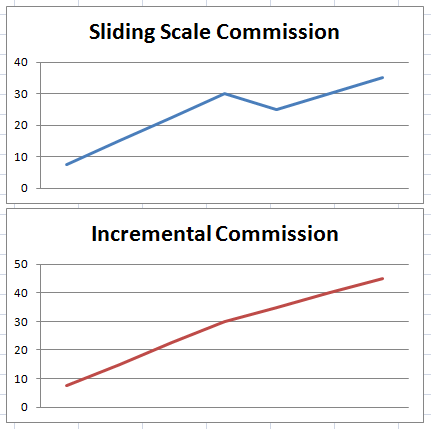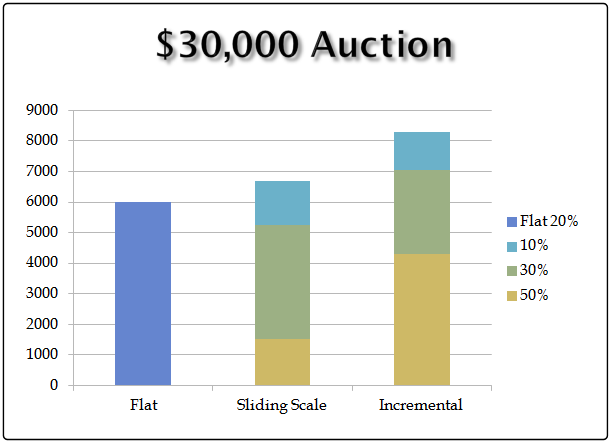The Great Sliding Scale Commission Debacle
Taxes and Sliding Scale Commissions; they both cost you money. One of them can be entirely avoided (legally).
There are 3 basic types of commission structures:
- Fixed rate – a single rate charged regardless of how much a lot sells for
- Sliding scale – a variable rate charged on the selling price of a lot
- Incremental – a multi-level rate charged in increments based on the selling price of a lot
Fixed rate is simple. Sliding scale is bad. Incremental is good. Let’s put together some real world examples of sliding scale and incremental to see why.
- Assume a commission structure of:
- 30% up to $100
- 20% up to $1,000
- When a lot sells for $100?
- Using sliding scale = $30 commission
- Using incremental = $30 commission
- When a lot sells for $110?
- Using sliding scale = $22 commission ($110 * 20%)
- Using incremental = $32 commission ($100 * 30% + $10 * 20%)
- Using sliding scale = $22 commission ($110 * 20%)
- When a lot sells for $150?
- Using sliding scale = $30 commission ($150 * 20%)
- Using incremental = $40 commission ($100 * 30% + $50 * 20%)
Compare the commissions at $100 hammer price vs the commissions at $110 hammer price. At $100 with sliding scale we made $30 commission. At $110 hammer price with sliding scale we only made $22. We actually gave back $8 in commission even though the hammer price increased $10! It’s not until $150 hammer price that the sliding scale commission gets back to $30 commission which was the same commission earned on $100 hammer price. Let’s visualize that:

Sliding scale looks like a lightning bolt. Lightning is bad. Incremental just goes up and up. Up is good.
Using sliding scale, the interest of the auctioneer (commission) is at odds with their fiduciary responsibility to the consignor. Commission should always increase with the hammer price. With a sliding scale commission structure your commission will drop at each and every level in your schedule. By contrast, an incremental commission structure always results in increasing commissions; it aligns the interests of the auctioneer with the consignor.
Now consider the effects of sliding scale commission on a 400 lot consignment auction that grosses $30,000. Let’s compare:
- Flat 20%
- Sliding scale – 50% up to $25, 30% up to $100, 10% thereafter
- Incremental – 50% up to $25, 30% up to $100, 10% thereafter

With flat we earned $6,000 commission
With sliding scale we earned $6,700 commission
With incremental we earned $8,280 commission
What’s interesting about the comparison is the 50% section of the sliding scale vs incremental. Notice how much bigger the 50% section is on incremental? That’s because we earned 50% of the first $25 of every lot that sold. With sliding scale we only earned 50% on the lots that sold for $25 or less. As you can see, that difference added up significantly on the entire auction.
Despite the shortcomings of sliding scale commission, its use is common place. Hopefully this blog post has, at the very least, persuaded you to give thought to the topic. It goes without saying, but it’s still worth mentioning: If you decide to start using incremental commission structures, make sure to update your consignor contract accordingly.
Is sliding scale really a debacle? Of course not; commission is commission. Please forgive the dramatic title!